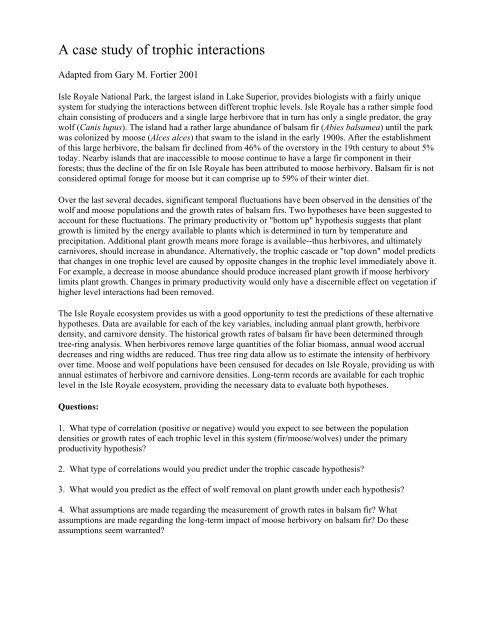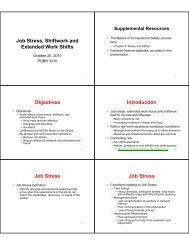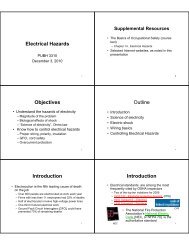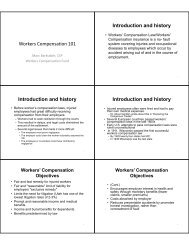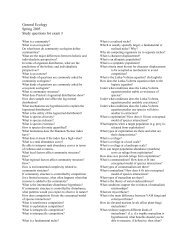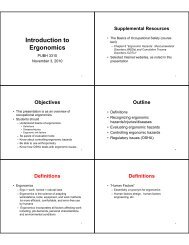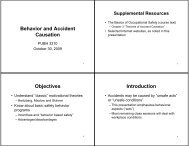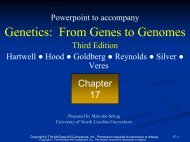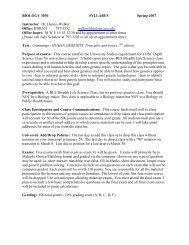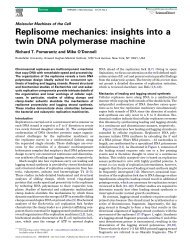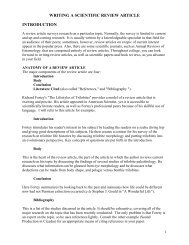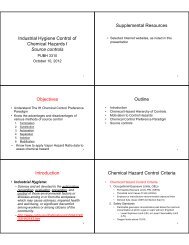A case study of trophic interactions
A case study of trophic interactions
A case study of trophic interactions
You also want an ePaper? Increase the reach of your titles
YUMPU automatically turns print PDFs into web optimized ePapers that Google loves.
A <strong>case</strong> <strong>study</strong> <strong>of</strong> <strong>trophic</strong> <strong>interactions</strong><br />
Adapted from Gary M. Fortier 2001<br />
Isle Royale National Park, the largest island in Lake Superior, provides biologists with a fairly unique<br />
system for <strong>study</strong>ing the <strong>interactions</strong> between different <strong>trophic</strong> levels. Isle Royale has a rather simple food<br />
chain consisting <strong>of</strong> producers and a single large herbivore that in turn has only a single predator, the gray<br />
wolf (Canis lupus). The island had a rather large abundance <strong>of</strong> balsam fir (Abies balsamea) until the park<br />
was colonized by moose (Alces alces) that swam to the island in the early 1900s. After the establishment<br />
<strong>of</strong> this large herbivore, the balsam fir declined from 46% <strong>of</strong> the overstory in the 19th century to about 5%<br />
today. Nearby islands that are inaccessible to moose continue to have a large fir component in their<br />
forests; thus the decline <strong>of</strong> the fir on Isle Royale has been attributed to moose herbivory. Balsam fir is not<br />
considered optimal forage for moose but it can comprise up to 59% <strong>of</strong> their winter diet.<br />
Over the last several decades, significant temporal fluctuations have been observed in the densities <strong>of</strong> the<br />
wolf and moose populations and the growth rates <strong>of</strong> balsam firs. Two hypotheses have been suggested to<br />
account for these fluctuations. The primary productivity or "bottom up" hypothesis suggests that plant<br />
growth is limited by the energy available to plants which is determined in turn by temperature and<br />
precipitation. Additional plant growth means more forage is available--thus herbivores, and ultimately<br />
carnivores, should increase in abundance. Alternatively, the <strong>trophic</strong> cascade or "top down" model predicts<br />
that changes in one <strong>trophic</strong> level are caused by opposite changes in the <strong>trophic</strong> level immediately above it.<br />
For example, a decrease in moose abundance should produce increased plant growth if moose herbivory<br />
limits plant growth. Changes in primary productivity would only have a discernible effect on vegetation if<br />
higher level <strong>interactions</strong> had been removed.<br />
The Isle Royale ecosystem provides us with a good opportunity to test the predictions <strong>of</strong> these alternative<br />
hypotheses. Data are available for each <strong>of</strong> the key variables, including annual plant growth, herbivore<br />
density, and carnivore density. The historical growth rates <strong>of</strong> balsam fir have been determined through<br />
tree-ring analysis. When herbivores remove large quantities <strong>of</strong> the foliar biomass, annual wood accrual<br />
decreases and ring widths are reduced. Thus tree ring data allow us to estimate the intensity <strong>of</strong> herbivory<br />
over time. Moose and wolf populations have been censused for decades on Isle Royale, providing us with<br />
annual estimates <strong>of</strong> herbivore and carnivore densities. Long-term records are available for each <strong>trophic</strong><br />
level in the Isle Royale ecosystem, providing the necessary data to evaluate both hypotheses.<br />
Questions:<br />
1. What type <strong>of</strong> correlation (positive or negative) would you expect to see between the population<br />
densities or growth rates <strong>of</strong> each <strong>trophic</strong> level in this system (fir/moose/wolves) under the primary<br />
productivity hypothesis?<br />
2. What type <strong>of</strong> correlations would you predict under the <strong>trophic</strong> cascade hypothesis?<br />
3. What would you predict as the effect <strong>of</strong> wolf removal on plant growth under each hypothesis?<br />
4. What assumptions are made regarding the measurement <strong>of</strong> growth rates in balsam fir? What<br />
assumptions are made regarding the long-term impact <strong>of</strong> moose herbivory on balsam fir? Do these<br />
assumptions seem warranted?
Trophic System Data<br />
The data below include census information for the moose and wolf populations, ring width indices from<br />
firs on each end <strong>of</strong> the island, and actual evapotranspiration rates (AET) from April to October. The east<br />
and west ends <strong>of</strong> the island differ substantially in terms <strong>of</strong> climate and flora. The west end consists <strong>of</strong><br />
hardwood forests with a higher AET rate and warmer, earlier summers relative to the boreal forests in the<br />
east. The AET rate varies with temperature and rainfall and serves as an index <strong>of</strong> the amount <strong>of</strong> water<br />
available for plant growth. This rate is strongly tied to primary productivity.<br />
Questions:<br />
5. Briefly describe the patterns or trends in each panel <strong>of</strong> Fig. 1. (A-E).<br />
Fig. 1. Population parameters <strong>of</strong> the Isle Royale<br />
ecosystem from 1958-1994. Shaded areas signify<br />
periods <strong>of</strong> forage suppression that may be<br />
connected to <strong>interactions</strong> between herbivores and<br />
carnivores.<br />
A. Population size <strong>of</strong> wolves each winter<br />
(based on aerial counts).<br />
B. Population size <strong>of</strong> moose each winter<br />
(based on aerial counts and skeletal<br />
remains).<br />
C. Ring-widths from the west end <strong>of</strong> Isle<br />
Royale, N=8.<br />
D. Ring-widths from the east end <strong>of</strong> Isle<br />
Royale, N=8.<br />
E. Actual evapotranspiration rates (AET),<br />
annual calculations based on data from<br />
April-October at a weather station 20 km<br />
from Isle Royale. AET is an<br />
approximation <strong>of</strong> primary productivity, it<br />
represents water availability as a function<br />
<strong>of</strong> temperature and rainfall.<br />
Image Credit Science 226 (December 2, 1994):<br />
1557<br />
6. How do the maxima and minima values <strong>of</strong> ring-width indices from the west end <strong>of</strong> the island correspond to<br />
changes in moose density? Does this support the primary productivity hypothesis, the <strong>trophic</strong> cascade hypothesis, or<br />
neither?<br />
7. How do the maxima and minima values <strong>of</strong> ring-width indices from the east end <strong>of</strong> the island correspond to<br />
changes in moose density? Does this support the primary productivity hypothesis, the <strong>trophic</strong> cascade hypothesis, or<br />
neither? What might account for any observed differences between the east and west end <strong>of</strong> the island?<br />
8. How do the maxima and minima <strong>of</strong> the wolves correspond to changes in moose density? How might you<br />
account for this relationship? Which hypothesis is supported by this relationship?<br />
9. Which hypothesis is supported by the data on annual AET?<br />
10. What final conclusions can you draw about the <strong>interactions</strong> between each <strong>trophic</strong> level on Isle Royale? Is<br />
control exerted from the top down, as suggested by the <strong>trophic</strong> cascade model, or are <strong>interactions</strong> between <strong>trophic</strong><br />
levels ultimately controlled by primary productivity?


